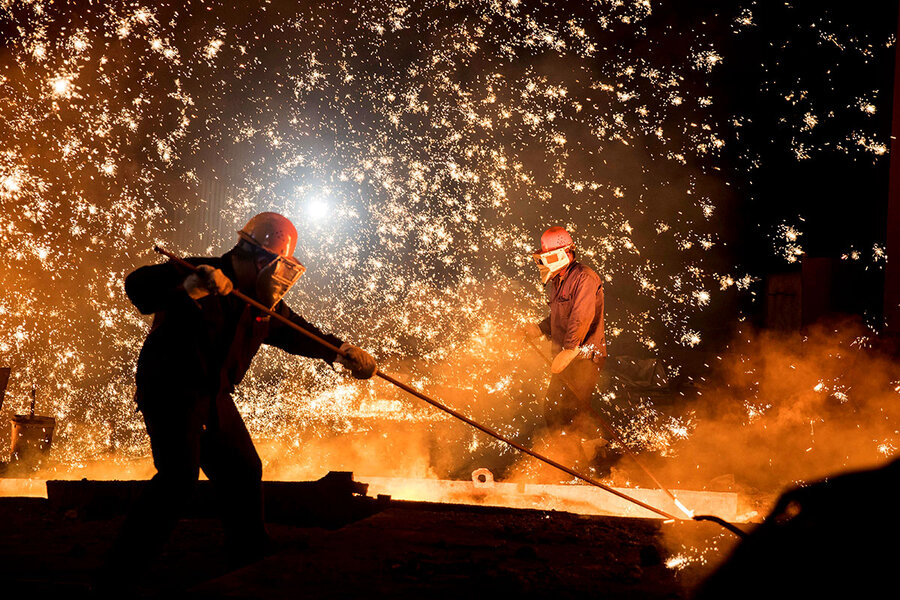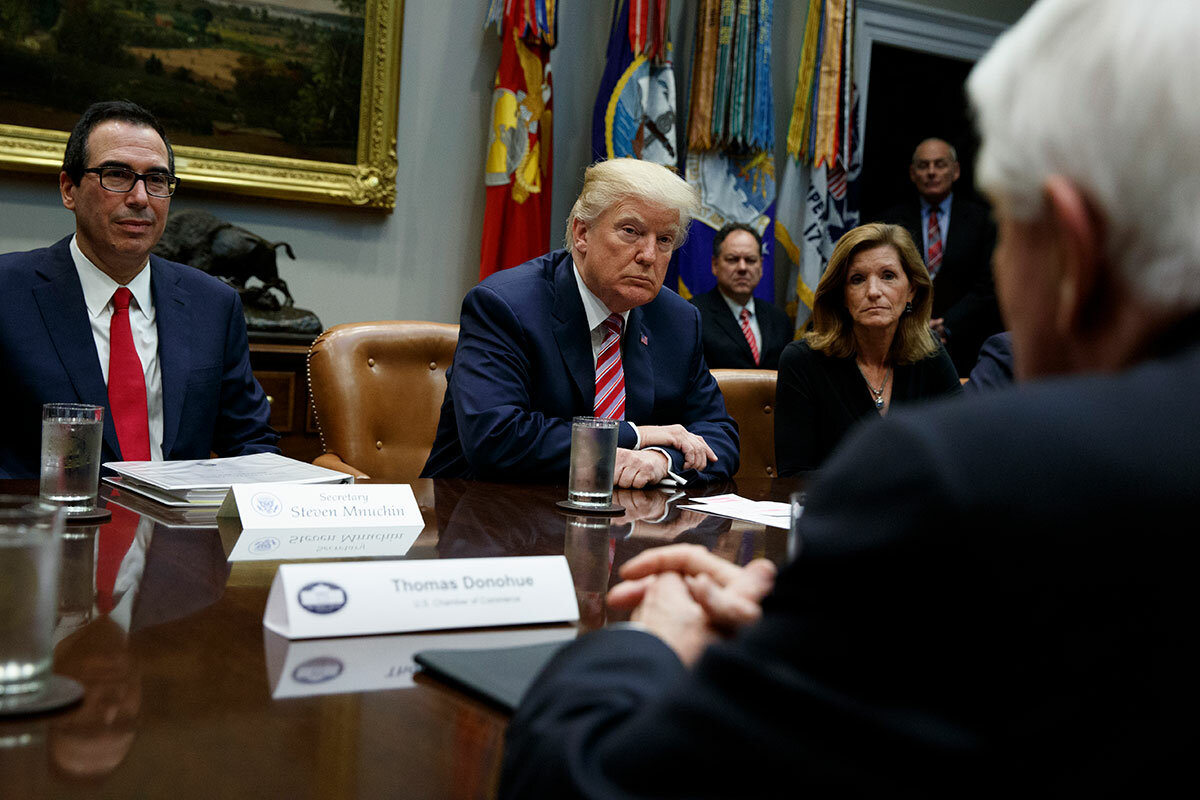Yes, a trade war could hurt everyone. But we're not there yet.
Loading...
The saber-rattling has been growing louder for months.
“We are losing to China,” US Trade Representative (USTR) Robert Lighthizer told a House committee on Wednesday.
“China is not afraid, nor will it dodge a trade war,” China’s former Vice Commerce Minister Wei Jianguo responded in an interview with Bloomberg.
On Thursday, the Trump administration pulled out its saber – announcing it would impose tariffs on at least $50 billion worth of Chinese goods pouring into the United States. That’s part of a gargantuan $568 billion trade deficit, the gap by which America’s imports exceeded its exports last year.
“It’s out of control,” President Trump said.
The list of specific Chinese products is expected in the next 15 days, after which the Chinese are expected to retaliate with similarly sized tariffs that will hit agricultural and other US goods flowing to China.
Although the sabers will be drawn, this is not a trade war – at least, not yet. The $50 billion in sanctions represent roughly a tenth of what China exported to the US last year. The tariffs don’t take effect until after a comment period in which the administration is expected to get a lot of pushback from industry, free-trade Republicans, and major trading partners.
“Pressure on the administration over this will be enormous,” says Edward Alden, a trade expert at the Council on Foreign Relations. “There’s a lot still to play out.”
The administration is also trying to tamp down fears of a trade war.
Sanctions as bargaining tools?
“We will end up negotiating over these things rather than fighting over them, in my view,” Commerce Secretary Wilbur Ross said at Thursday’s announcement.
The administration has plenty of justification taking on China, trade experts say, because China is playing by its own rules in trade. Rather than close down unprofitable state-owned factories, it has subsidized them and allowed them to glut world markets with steel, solar panels, and other goods. It has forced Western companies that want to sell in China to transfer technology to Chinese partners. And it has used licensing and other barriers to protect its industries from foreign competition.
The problem, critics say, is the isolated way in which Mr. Trump has taken on China. Rather than working through the World Trade Organization (WTO), his latest moves represent an end run around a system that could provide useful leverage in the future. Rather than build a coalition of nations, many of which are also frustrated by China’s mercantilist ways, Trump is going it alone and alienating potential partners with threats of more trade actions against them.
“While it’s well past time to tell China ‘enough is enough,’ we caution USTR from imposing tariffs, particularly on producer goods like computers,” the Information Technology and Innovation Foundation, a Washington think tank, said in a statement. “These won’t bring production back to America, but they will raise prices, which will reduce capital investment, lower productivity, and weaken U.S. competitiveness.”
Signs of flexibility
Stock prices plummeted Thursday, with the trade sanctions contributing to a 724-point loss for the Dow Jones Industrial Average, its biggest in more than a month.
Nevertheless, the administration is showing some flexibility. USTR Mr. Lighthizer told a Senate panel Thursday that the European Union, Argentina, Brazil, South Korea, and Australia would not be subject to recently announced US steel and aluminum tariffs, joining Mexico and Canada, which also have at least a temporary reprieve.
The biggest test of US intentions could come later this year, when the administration wraps up an investigation into China’s trade practices, especially its requirement that US firms in China transfer technology to Chinese partners.
“We believe the trade actions with the most significant potential economic and market impact – particularly the investigation into China’s use of American intellectual property – have yet to unfold,” Libby Cantrill and Tiffany Wilding of investment house PIMCO wrote in a blog post last week. “We could see President Trump imposing widespread tariffs, potentially even on consumer electronics (like phones), and scaling back Chinese investment in the U.S.”
Some experts remain optimistic that the economic stakes are high enough that neither country will rush toward a confrontation.
Interdependent nations
“Neither the US nor China wants to create total economic chaos for the other or for itself, and both nations actually have a surprising degree of economic inter-dependence today,” Nelson Dong, co-head of the Asia group at international law firm Dorsey & Whitney, writes in an email. “My hope (and it is only that) and my own professional expectation is that there will be some very bruising, unpleasant and even damaging battles and certainly a great deal of aggressive and heated rhetoric but no true ‘trade war’ as such.”
But that hope depends on the idea that reason will prevail. And the Chinese are seeing the trade tariffs as only a part of a much larger US broadside against China, says Mr. Alden of the Council on Foreign Relations, who spent four days this week in China. “They are apoplectic over something that nobody in the United States has paid any attention to.”
On Friday, Mr. Trump signed the Taiwan Travel Act, which upgrades the kind of visits US officials can make to the island, which China perceives as a slap to its One China policy.
That move, combined with Trump’s branding of China as a “revisionist” power and the unprecedented scale of the trade sanctions outside international rules of trade, could stoke Beijing’s anger.
The last real trade war: 1930s
“None of us have seen this in our lifetime,” says Alden. When the Reagan administration confronted Japan over trade in the 1980s, it had specific demands it wanted addressed – not a vague economic target. When Congress enacted the infamous Smoot-Hawley tariffs in 1930, there were no global trading rules for the US to circumvent.
Those tariffs are often invoked as a warning against protectionism. But they didn’t spark the Depression, which was already under way, and they didn’t trigger a larger trade war, points out economic historian Douglas Irwin, a professor at Dartmouth College. The beggar-thy-neighbor trade policies erupted after a global financial crisis in 1931.
What the tariffs did do was lengthen the Depression, he argues, and cause Congress eventually to put trade in the hands of the president, who according to the thinking of the time would negotiate trade-liberalizing accords.
Staff writer Mark Trumbull contributed to this story from Washington.







